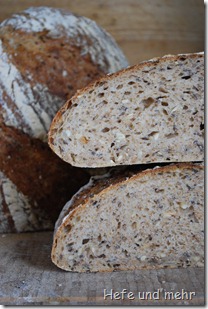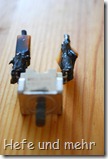
I did not planed to post this recipe (I posted some similar recipes already) but the boyfriend praised this bread so much that I decided to write it down in case he asked me to bake it again.
For this bread I had to smuggle sunflower seeds in the house and to my surprise he did not find it in the pantry. But as soon as I opened the package he appeared in the kitchen and started to nibble the seeds. But at this time I had the amount I needed already weighed.
I used two preferments for this bread: Sourdough and Pâte fermentée which gave a lot of flavour to the bread while the soaked rolled oats and flax seeds made it nicely moist.

In picture on the right side you can see why the oven was broken. The fuse is so much burned that I am relived that oven just turned itself of and did not burn down! The repair cost 80 Euro that is 10 Euro less then calculated so I am happy! I’m just hoping that this fuse will last longer then two years!
And before we finish all bread I sent this recipe to Susan’s weekly Yeastspotting.
Seeded Bread with two preferments
Sourdough
- 250g flour Type 550
- 175g water
- 30g sourdough starter
Pâte fermentée
- 120g flour Type 550
- 85g water
- 1g fresh yeast
- 2g salt
Soaker
- 75g rolled oats
- 75g flax seeds
Dough
- 500g flour Type 550
- 500g wheat, freshly milled
- 700g Water
- 2g fresh yeast
- 28g salt
- 50g spelt
- 150g sunflower seeds
- 50g sesame
Mix all ingredients for the Pâte fermentée and proof it for 1 hour at room temperature. Then put the dough into the fridge for 12 hours.
Mix the ingredients for the sourdough and ferment for 12 hours at room temperature.
The next day: Cook the spelt in water until soft (about 40 min) and let cool down.
Soak the rolled oats and flaxseeds in hot water for 1 hour.
Toast the sunflower seeds and the sesame until golden and let cool down.
Now mix the different flours with the water, yeast, pate fermentée and the sourdough and rest it for 20 min (Autolysis).
Now add the salt and knead 5 min ad the slowest speed and 5 min ad higher speed until medium gluten development. Pour the remaining water from the soaker away. Then add the Soaker, the spelt and the seeds to the dough at slow speed, knead just as long as needed, so the gluten will not be destroyed.
Now place the dough in a good oiled container and ferment for 3 hours. Give the dough three folds during this time.
Folding: Flour your countertop and put the dough on it. Flat the dough carefully to a square. Now fold the right and the left side to the middle, then from button and top, too. You can find a nice tutorial here.
After fermenting divide the dough into two equal parts. Preshape into a square. Rest for 20 min. Then form in a bread and proof in brotforms for 90 min.
In the meantime heat baking stone in the oven to 250°C.
Slash two times and bake the loaves on the hot stone for about 45 min with steam, until the crust is golden brown.
Deutsch



Wow, vielen lieben Dank, dass Sie mir so schnell geantwortet haben – und das noch dazu mit einer überarbeiteten Version des Rezeptes!!! Brot ist bereits in Arbeit (in der halben Menge, da heute Nachmittag bereits die Sesamsonnen duftend aus dem Rohr gekommen sind und die Gesamtmenge für eine dreiköpfige Familie dann doch zu viel wäre 😉)
Vielen lieben Dank für die vielen tollen Rezepte!!!
@M: Gern geschehen! Berichte doch mal, wie das Brot geworden ist 🙂
danke!! es ist wunderbar geworden, alles perfekt: aussehen, geschmack, kruste, krume, frischhaltung – vielen dank für das tolle Rezept!! auch alte “Schätzchen” sind schätze 🙂
@M: Das freut mich!
Soll ich das Wasser für das Garen des Dinkels und für das Haferflocken-Leinsamen-Brühstück vom Wasser des Hauptteiges wegnehmen (d.h. von den 700g) oder ist dieses Wasser bei den Zutaten nicht angeführt, weil das überflüssige nachher ja abgegossen wird, bevor Dinkel & Brühstück in den Hauptteig kommen? Wie viel Wasser sollte ich für Dinkel und Brühstück verwenden? Liebe Grüße!
@M: Hui, da hast du ein ganz altes Schätzchen ausgegraben. Acht Jahre später würde ich an der einen oder anderen Stelle tatsächlich etwas anders formulieren und das Vorgehen mal auch ein bisschen feinschleifen. Den Dinkel kannst du einfach kochen und abtropfen lassen. Beim Quellstück würde ich alle Saaten quellen lassen, und direkt auch mit einer passenden Wassermenge und dafür im Teig ein wenig weniger Wasser nehmen 🙂 Die Mengen habe ich dir unten aufgeschrieben.
Und das Rezept gibt zwei Brote von je 1,4 kg – evtl. machst du besser nur die Hälfte 0:-)
Sauerteig
250g Mehl Type 550
175g Wasser
30g Sauerteig
Kochstück
50g Dinkel
Quellstück
75g Haferflocken
75g Leinsamen
150g Sonnenblumenkerne
50g Sesam
275g Wasser
Pâte fermentée
120g Mehl Type 550
85g Wasser
1g frische Hefe
2g Salz
Teig
500g Mehl Type 550
500g Weizen, frisch gemahlen
650g Wasser
2g frische Hefe
28g Salz
Da Herr C. Brote mit Saaten und Körnern nicht so schätzt, habe ich schon länger keines mehr gebacken.
Wenn ich Dein Brot aber so betrachte komme ich zu dem Schluss, das ich aber unbedingt wieder eines essen möchte.